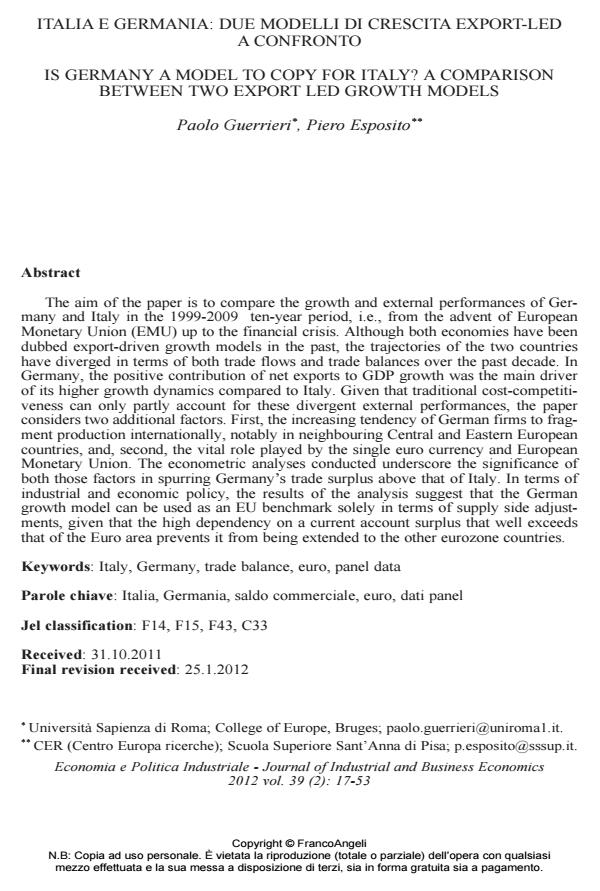Italia e Germania: due modelli di crescita export-led a confronto
Titolo Rivista ECONOMIA E POLITICA INDUSTRIALE
Autori/Curatori Paolo Guerrieri, Piero Esposito
Anno di pubblicazione 2012 Fascicolo 2012/2
Lingua Italiano Numero pagine 37 P. 17-53 Dimensione file 458 KB
DOI 10.3280/POLI2012-002002
Il DOI è il codice a barre della proprietà intellettuale: per saperne di più
clicca qui
Qui sotto puoi vedere in anteprima la prima pagina di questo articolo.
Se questo articolo ti interessa, lo puoi acquistare (e scaricare in formato pdf) seguendo le facili indicazioni per acquistare il download credit. Acquista Download Credits per scaricare questo Articolo in formato PDF

FrancoAngeli è membro della Publishers International Linking Association, Inc (PILA)associazione indipendente e non profit per facilitare (attraverso i servizi tecnologici implementati da CrossRef.org) l’accesso degli studiosi ai contenuti digitali nelle pubblicazioni professionali e scientifiche
The aim of the paper is to compare the growth and external performances of Germany and Italy in the 1999-2009 ten-year period, i.e., from the advent of European Monetary Union (EMU) up to the financial crisis. Although both economies have been dubbed export-driven growth models in the past, the trajectories of the two countries have diverged in terms of both trade flows and trade balances over the past decade. In Germany, the positive contribution of net exports to GDP growth was the main driver of its higher growth dynamics compared to Italy. Given that traditional cost-competitiveness can only partly account for these divergent external performances, the paper considers two additional factors. First, the increasing tendency of German firms to fragment production internationally, notably in neighbouring Central and Eastern European countries, and, second, the vital role played by the single euro currency and European Monetary Union. The econometric analyses conducted underscore the significance of both those factors in spurring Germany’s trade surplus above that of Italy. In terms of industrial and economic policy, the results of the analysis suggest that the German growth model can be used as an EU benchmark solely in terms of supply side adjustments, given that the high dependency on a current account surplus that well exceeds that of the Euro area prevents it from being extended to the other eurozone countries.
Parole chiave:Italy, Germany, trade balance, euro, panel data Parole chiave: Italia, Germania, saldo commerciale, euro, dati panel
Jel codes:F14, F15, F43, C33
- The financing methods for small and medium companies: comparison between Italy and Germany Matteo Rossi, Elisa Giacosa, Alberto Mazzoleni, in Corporate Ownership and Control /2016 pp.366
DOI: 10.22495/cocv13i3c2p9 - German and Italian manufacturing performances: a premise to a comparison Alessandro Arrighetti, Augusto Ninni, in ECONOMIA E POLITICA INDUSTRIALE 2/2012 pp.5
DOI: 10.3280/POLI2012-002001 - Autonomia "metropolitana" del Veneto. Sviluppo e governance di un territorio complesso Paolo Gurisatti, in ECONOMIA E SOCIETÀ REGIONALE 1/2017 pp.30
DOI: 10.3280/ES2017-001004
Paolo Guerrieri, Piero Esposito, Italia e Germania: due modelli di crescita export-led a confronto in "ECONOMIA E POLITICA INDUSTRIALE " 2/2012, pp 17-53, DOI: 10.3280/POLI2012-002002